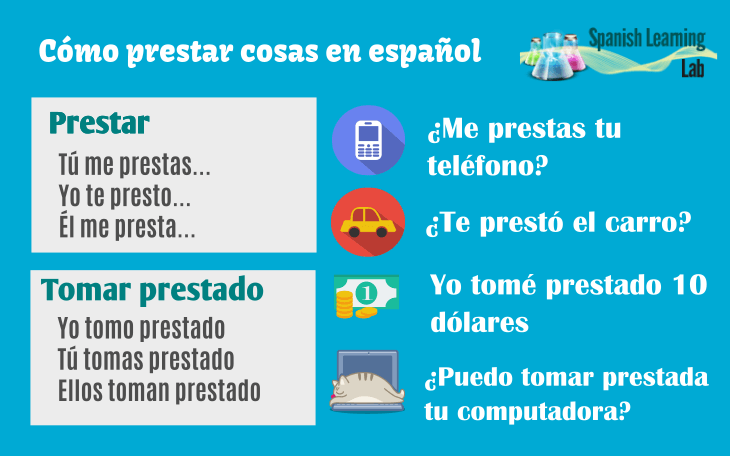Hola. In this short lesson, you will learn ways to borrow and lend things in Spanish. We have included several examples with people borrowing or lending stuff, as well as two listening activities and interactive quizzes to test your understanding of the content in the lesson and your listening ability. Let’s start…

How to borrow or lend things in Spanish – Como prestar cosas
You may have already noticed that we used the verb “PRESTAR” in the examples in the picture above. This regular verb is exactly what we need to talk about borrowing and lending things in Spanish, and it will be used in two different forms in order to differentiate lending from borrowing in Spanish.
Lending stuff in Spanish
In sentences about lending stuff in Spanish, we must place an object pronouns (me, te…) before the form of the verb “PRESTAR”, e.g. “Me prestas (a mí)” (You lend me), “Te presto (a ti)” (I lend you) and “Nos prestan” (they lend us). Likewise, you can ask another person to lend you something by adding an indirect object pronoun just after PRESTAR, e.g. “Préstame tu auto por favor” (Please lend me your car) or “Debería prestarle algo de dinero” (I should lend him some money).
As you can see, the indirect pronoun tells who will receive the thing you are lending. This way, in the question “¿Me prestas tu libro?“, I am the one asking for the book, whereas in a sentence like “Siempre te presto dinero“, the indirect object pronoun “TE” tells that I am the one who lends money to “you”. Read carefully and listen to the following group of examples:
|
Ana me presta su auto los fines de semana.
Ana lends me her car on weekends.
|
|
¿Necesitas que te preste un bolígrafo?
Do you need me to lend you a pen?
|
|
Ellos acaban de mudarse. Yo les presté algunas cosas.
They just moved in. I lent them some things.
|
|
¿Me puedes prestar ese libro de Ciencias Naturales?
Can you lend me that Natural Science book?
|
|
No le prestes más dinero a Carlos. Es muy mala paga.
Don’t lend Carlos any more money. He is a bad late payer.
|
|
Préstame tu cargador por favor. Olvidé el mio en casa
Lend me your charger please. I forgot mine at home.
|
Borrowing stuff in Spanish
For borrowing things in Spanish, we could use the phrase “TOMAR PRESTADO” (which literally means “take it lent”). When borrowing something, there is no need to use any object pronoun, but we need to conjugate the verb “TOMAR” properly following the rules for regular verbs. That being said, we can easily say something like “I borrow a pen” this way: “Yo tomo prestado un bolígrafo“.
Generally, in order to ask for something or make requests in Spanish, we must use the verb PODER in the correct form for each pronoun plus the phrase “tomar prestado” phrase, for example: “¿Puedo tomar prestado tu auto?” (Can I borrow your car?). Keep in mind that some ways to ask questions in Spanish are much more polite than others, as we discussed in previous lessons. Read and listen to the following set of examples before practicing with both listening activities:
| Marcela tomó prestada mi computadora esta mañana. Marcela borrowed my computer this morning. |
|
Los niños tomaron prestados los juguetes de Pedro.
The children borrowed Pedro’s toys.
|
|
Disculpe ¿Puedo tomar prestado su libro un momento?
Excuse me, can I borrow your book for a moment?
|
|
¡Espera! No tomes prestada la impresora sin permiso.
Wait! Do not borrow the printer without permission.
|
|
Recuerda pedir prestado el proyector antes de la presentación.
Remember to borrow the projector before the presentation.
|
|
Alejandro ¿Quién tomó prestado mi portafolio?
Alejandro, who borrowed my portfolio?
|
Listening Activity No. 1: What are they lending or borrowing in Spanish?
Listening Activity No. 2: Borrowing and lending things in Spanish
Key Spanish phrases in the conversation:
- “Hacer mandados” means “To run errands”
- “No funciona bien” means “Doesn’t work very well”
- “Pedir prestado” means “Ask someone to lend you something”
Thanks for making it to the end of this lesson. If you have the chance, borrow something from a Spanish speaker or lend something to him/her spontaneously to see their reaction. Then, check if what you learned from this lesson matches what you heard a bit. ¡Hasta la próxima!
